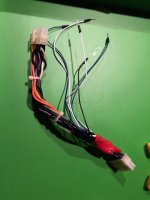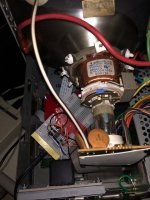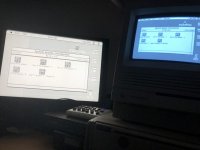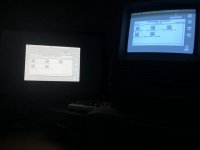sqpat
Experienced Member
I wanted to capture a Mac SE/30 video signal for streaming and recording. I think there are a couple PDS slot cards capable of this stuff but they're rare and expensive and have various issues. I heard about some adapters people had built and they seem to stem from the section on page 168 of "Macintosh Repair & Upgrade Secrets" which can be seen here: http://vintageapple.org/macbooks/pdf/Macintosh_Repair_&_Upgrade_Secrets_1990.pdf
For Mac SE/30 the logic board pinout is a little different and can be found here. https://i.stack.imgur.com/wMsyQ.png
Im sure this is just as possible for any other model if you know the pinout. You just need video, Hsync, Vsync, +5v, and ground.
It's a very simple circuit where you basically split signals off the macintosh's logic board cable and run it through a single IC (a Schmidt Trigger) and line up wires with those on a VGA cable. The original adapter is for a TTL display, but you will be fine with a VGA cable if you toss the intensity wire and mirror the video signal to R/G/B.
Here are some photos of how mine turned out. I'm really bad at this stuff and used a breadboard for minimal soldering and it still worked.
Logic board cable after some soldering. I couldnt get the wires out of the molex-like connector to do heat shrink so I just used electrical tape.

I just used a breadboard to make things easier. Seems to work fine!

I ended up getting the board arranged in a better way than this, but I run a VGA cable out of the case that I can then hook up to anything.

Monitor in stretch mode

Monitor in 1:1 Mode

Remember, this circuit doesn't do scan conversion. My LCD display (Dell U2410) actually can actually sync to the signal fine, and I'm sure most CRTs can probably tolerate it. But for a little better quality I use an OSSC (open source scan converter) with the following parameters for an optimal conversion.
(22.24kHz 59.78Hz)
(Under 400p settings)
H sample rate 704
H synclen 14
H backporch 164
H active 512
V synclen 1
V backporch 29
V active 342
384/400 Scaling: 2x
Adjust horizontal sampling phase to get rid of "waviness" in the signal.
It's still not perfect. There's a persistent vertical artifact 1/3rd from the left of the screen. It seems the signal gets a little "stretched" after that artifact. But its pretty close to perfect, so I'm not complaining too much! It turned out quite easy to build.
For Mac SE/30 the logic board pinout is a little different and can be found here. https://i.stack.imgur.com/wMsyQ.png
Im sure this is just as possible for any other model if you know the pinout. You just need video, Hsync, Vsync, +5v, and ground.
It's a very simple circuit where you basically split signals off the macintosh's logic board cable and run it through a single IC (a Schmidt Trigger) and line up wires with those on a VGA cable. The original adapter is for a TTL display, but you will be fine with a VGA cable if you toss the intensity wire and mirror the video signal to R/G/B.
Here are some photos of how mine turned out. I'm really bad at this stuff and used a breadboard for minimal soldering and it still worked.
Logic board cable after some soldering. I couldnt get the wires out of the molex-like connector to do heat shrink so I just used electrical tape.

I just used a breadboard to make things easier. Seems to work fine!

I ended up getting the board arranged in a better way than this, but I run a VGA cable out of the case that I can then hook up to anything.

Monitor in stretch mode

Monitor in 1:1 Mode

Remember, this circuit doesn't do scan conversion. My LCD display (Dell U2410) actually can actually sync to the signal fine, and I'm sure most CRTs can probably tolerate it. But for a little better quality I use an OSSC (open source scan converter) with the following parameters for an optimal conversion.
(22.24kHz 59.78Hz)
(Under 400p settings)
H sample rate 704
H synclen 14
H backporch 164
H active 512
V synclen 1
V backporch 29
V active 342
384/400 Scaling: 2x
Adjust horizontal sampling phase to get rid of "waviness" in the signal.
It's still not perfect. There's a persistent vertical artifact 1/3rd from the left of the screen. It seems the signal gets a little "stretched" after that artifact. But its pretty close to perfect, so I'm not complaining too much! It turned out quite easy to build.

